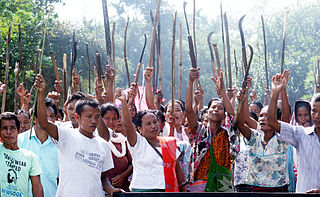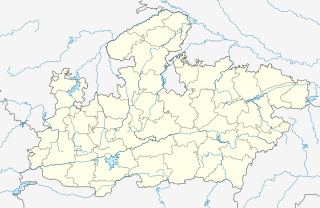
Madhya Pradesh is a state in central India. Its capital is Bhopal, and the largest city is Indore, with Jabalpur, Gwalior, Rewa, and Ujjain being the other major cities. Madhya Pradesh is the second largest Indian state by area and the fifth largest state by population with over 75 million residents. It borders the states of Uttar Pradesh to the northeast, Chhattisgarh to the southeast, Maharashtra to the south, Gujarat to the west, and Rajasthan to the northwest.

Gwalior is a major city in the central Indian state of Madhya Pradesh and one of the Counter-magnet cities. Located 343 kilometres (213 mi) south of Delhi, the capital city of India, 120 kilometres (75 mi) from Agra and 414 kilometres (257 mi) from Bhopal, the state capital, Gwalior occupies a strategic location in the Gird region of India. The historic city and its fortress have been ruled by several historic northern Indian kingdoms. From the Kachchhapaghatas in the 10th century, Tomars in the 13th century, it was passed on to the Mughal Empire, then to the Maratha in 1754, followed by the Scindia in the 18th century. A study of urban pollution in 2016 found the city to have the highest level of air pollution in India, and the second highest in the world.

Madhya Bharat, also known as Malwa Union, was an Indian state in west-central India, created on 28 May 1948 from twenty-five princely states which until 1947 had been part of the Central India Agency, with Jiwajirao Scindia as its Rajpramukh.
Malwa is an Indian historical doab region of west-central India occupying a plateau of volcanic origin. Geologically, the Malwa Plateau generally refers to the volcanic upland north of the Vindhya Range. Politically and administratively, it is also synonymous with the former state of Madhya Bharat which was later merged with Madhya Pradesh, and presently the historical Malwa region includes districts of western Madhya Pradesh and parts of south-eastern Rajasthan, sometimes the definition of Malwa is extended to include the Nimar region south of the Vindhyas.

Vidisha is a city in the state of Madhya Pradesh, India. It is located 62.5 km northeast of the state capital, Bhopal. The name "Vidisha" is derived from the nearby river "Bais", mentioned in the Puranas.

Bandh is a form of protest used by political activists in South Asian countries such as India and Nepal. It is similar to a general strike. During a bandh, a political party or a community declare a general strike. For example, a Bharat bandh is a call for a bandh across India, and a bandh can also be called for an individual state or municipality.
Joshi is a surname used by the Brahmins (caste) in India and Nepal. Joshi is also sometimes spelled as Jyoshi. The name is popularly derived from the Sanskrit word Jyotisha, referring to Vedic Astrology and astronomy; in turn, Jyotisha is derived from Jyotish. Joshi is a common family name in Delhi, Gujarat, Karnataka, Madhya Pradesh, Maharashtra, Odisha, Punjab, Rajasthan, Uttarakhand, Goa and Uttar Pradesh in India and Nepal. In Nepal, the surname Joshi is used by Newar Srēṣṭhas.

Palanpur is a city and a municipality of Banaskantha district in the Indian state of Gujarat. Palanpur is the administrative headquarters of the district. Palanpur is the ancestral home to an industry of Indian diamond merchants.

Ambaji (Ambājī) is a census town in Banaskantha district in the state of Gujarat, India. It is known for its historical connections with sites of cultural heritage.

Kailash Kher is an Indian playback singer and music composer, he sang songs with a music style influenced by Indian folk music and Sufi music. He was inspired by the classical musicians Pandit Kumar Gandharva, Pandit Hridaynath Mangeshkar, Pandit Bhimsen Joshi, and the Qawwali singer Nusrat Fateh Ali Khan.

The following outline is provided as an overview of, and topical guide to, India:

The history of the Indian state Madhya Pradesh is divided into three periods. During the ancient period, the region was dominated by the Nanda, Maurya, and Gupta Empires.

Ganj Basoda, called Basoda, city and municipality in the Indian state of Madhya Pradesh. Ganj Basoda is one of the eleven tehsils of Vidisha district ganj Basoda 39 km from Vidisha.
Manasa Vidhan Sabha constituency is one of the Vidhan Sabha constituencies of Madhya Pradesh state in central India. This constituency came into existence in 1951 as one of the 79 Vidhan Sabha constituencies of the erstwhile Madhya Bharat state.

Bharat Bhavan is an autonomous multi-arts complex and museum in Bhopal, India, established and funded by the Government of Madhya Pradesh.The architect of Bharat Bhavan is Charles Correa. Opened in 1982, facing the Upper Lake, Bhopal, it houses multiple art galleries, a graphic printing workshop a ceramics workshop, an open-air amphitheater, a studio theatre, an auditorium, a museum tribal and folk art, libraries of Indian poetry, classical music as well as folk music.

Kailash Vijayvargiya is an Indian politician serving as national general secretary of the Bharatiya Janata Party (BJP). He started his political career in the Indore Bharatiya Janata Party, and was the mayor of Indore, a six-time legislator who has never lost an assembly election, and a state government cabinet minister for over 12 years before being elevated to the party's central leadership.

The Galteshwar is a Hindu temple dedicated to Shiva, located at Sarnal village near Dakor in Kheda district, Gujarat, India. The 12th century temple is unique in its style and of its period because it is built in central Indian Malwa style, bhumija, without influence of Paramara architecture and with influence of Gujarati Chaulukya architecture. It has a square garbhagriha as well as octagonal mandapa.
Krishna Pal Singh was an Indian activist, politician and a former Governor of Gujarat. His career began in the 1940s and ended in the 1990s.













